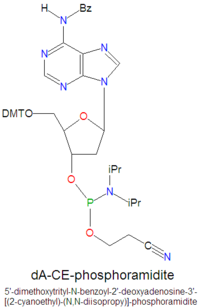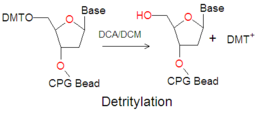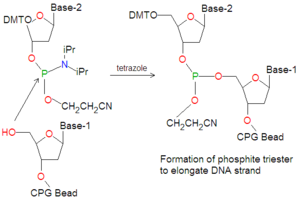DNA synthesis (chemical)
DNA is often chemically synthesized in research laboratories, or by commercial entities, for many reasons. For example, DNA sequencing often relies on short DNA primers which must be synthesized. DNA-based aptamers and thioaptamers, which are nucleic acid-based protein-binding affinity reagents that can be used in place of an antibody in assays, are a more recent use. Another use is the creation of small DNA strands, coding for a particular protein, that can be ligated into a much larger bacterial plasmid for protein over-expression. Directed mutagenesis of over-expressed proteins also relies on synthesized DNA. The DNA is synthesized on an automated machine by passing a variety of solvents and reagents through a solid support under anhydrous conditions.
Conventional DNA synthesis
During chemical DNA synthesis, as opposed to biological DNA synthesis, using phosphoramidite reagents (Fig. 1), four steps are typically used for each DNA base addition: 1) deprotection of the growing DNA strand, 2) coupling of the new base, 3) capping (termination) of failed strands, and 4) oxidation. Finally, once the entire DNA strand has been synthesized, the DNA is subjected to ammoniolysis (concentrated ammonium hydroxide) to cleave away the support and deprotect the DNA bases. Each of these steps is discussed in more detail below. The phosphoramidite method of synthesis most of used today was developed by Beaucage and Caruthers.[1] Although "reverse" phosphoramidites are new available to synthesis the DNA starting from the 5'-end and proceeding to the 3'-end, most synthesis carried out proceeds from the 3'-end to the 5'-end.
DNA synthesis begins with a single, protected DNA base attached (on the 3'-side) to a solid support, typically ~ 70 micron beads made of controlled pore glass or polystyrene/divinylbenzene, although a variety of support materials and sizes are now available, including non-cleavable beads and heat-labile beads. Because the nucleophilic amine groups of natural DNA bases can undergo coupling chemistry, the base attached to the bead, and the phosphoramidites later added to the bead, have protecting groups on the bases to ensure only phopho-based coupling reactions occur. These protected base forms have tradionally been N2-isobutyryl-dG, N4-benzoyl-dC, and N6-benzoyl-dA, which require about 16 hours of deprotection in concentrated ammonium hydroxide (28-33% NH3 in water) at 55C. More recent protected forms such as phenoxyacetyl-dA (PAC-dA), dimethylformadinyl-dG (DMF-dG), and acyl-dC can be deprotected quickly in milder conditions(Reddy, M. et al., 1994). Most phosphoramidites and the initial base are also protected at the 5'-oxygen atom by a dimethoxytrityl group (DMT), although some specialty chemical linkers and dyes are sometimes protected with a monomethoxytrityl group (MMT). Once the DNA beads are loaded onto a DNA synthesizer, typically in a column packed between two frits, the first step, DMT removal, begins.
Deprotection of the 5'-DMT group The 5'-dimethoxytrityl group on the bead support is acid labile and it is removed quickly (~ 30 seconds) by addition of dichloroacetic acid in methylene chloride (Scheme 1). Subsequent washing of the beads with acetonitrile minimizes loss of DNA base protecting groups on the bead and on subsequent phosphoramidites. The resulting dimethoxytrityl cation flushed away is bright orange and provides a spectrometric estimate of coupling efficiency at the end of each base addition. However, due to differing kinetics (ie reaction rates) of detritylation, the dG bases always provide a smaller signal than do the other DNA bases. The final DNA base of a DNA strand can be detritylated using other methods, such as using 80% acetic acid.
Elongation of the DNA is then promoted by the addition of an "activator", typically tetrazole, a weak acid, and a phosphoramidite (Scheme 2). The weak acid activates the phosphorus atom of the phosphoramidite, thereby increasing the rate of successful nucleophilic addition of the unprotected 5'-oxygen atom of the DNA strand to the P atom. An excess of phosphoramidite (compared to the bead support) ensures near complete coupling (99+%). Although this reaction takes about 30 seconds, longer coupling times, or double coupling steps, can be used to ensure more complete coupling. Although 99% success at each coupling stage seems excellent, when longer DNA strands are synthesized, 99% efficiency can be catastrophic. For example, for a DNA strand with 201 bases, which requires 200 addition reactions, yields only a final yield of 13.4% ( 0.99200 ) before deprotection and column purification. After the coupling period, the excess reagents are flushed away with acetonitrile to minimize any side reactions with the bases. At this stage, the newly formed linkage is an unstable trivalent phosphite triester which must be oxidized before it will be stable. For normal DNA synthesis, capping generally occurs before oxidation, but for the synthesis of monothioated or dithioated DNA linkages, sulfur-oxidation must occur before the capping step.
Capping of the DNA failure sequences ensures that no deletion products get synthesized. If a particular DNA strand on a bead is not elongated by the addition of the phosphoramidite, an unprotected 5'-oxygen atom remains and it would be available to react in the next cycle of synthesis unless it is capped. Capping is done by the addition of acetic acid anhydride in tetrahydrofuran (THF) and 1-methylimidazole in THF/pyridine to form an unreactive ester, effectively terminating the DNA strand so that no further coupling reactions can occur. The relative amounts of reagents and solvents differ by synthesizer manufacturer.
Oxidation of the trivalent phosphite triester to a trivalent phosphate triester is typically the last step of each cycle. However, thio-oxidation, if used, must precede the capping step. Oxidation of the phosphate atom is accomplished by the addition of 0.02 M iodine in THF/Water/pyridine. Thio-oxidation is accomplished by the addition of either 3H-1,2-benzodithiol-3-one 1,1-dioxide, popularly known as Beaucage Reagent[2], or the newer reagent 3-((Dimethylamino-methylidene)amino)-3H-1,2,4-dithiazole-3-thione (DDTT). The oxidation step takes about 1 minute, but multiple oxidation steps can be used to ensure the highest possible yield, and is desirable when doing thio-oxidation steps. When dithioated DNA linkages, which contain two non-bridging sulfur atoms, are desired, a thiophosphoramidite must be used instead of a normal phosphoramidite, and thio-oxidation must then occur. In this instance, thio-oxidation occurs before the capping step.
Final detritylation - Depending on the anticipated purification method to be used, the 5'-DMT group of the last base added may or may not be removed. Generally, if HPLC/FPLC methods are used, the DMT group is left on, and if gel purification will be used, the DMT is removed.
Post-synthesis treatment
Once the entire DNA strand has been synthesized, the DNA is still attached to a synthetic bead, is protected on all of the dA, dC and dG bases, is capped at the 5'-ends of failure sequences, and is still in the form phoshate triesters at all phosphorus atoms, rather than the normal phosphate linkage present in normal DNA. These issues are all dealt with by ammoniolysis. The DNA beads are subjected to concentrated ammonium hydroxide. Typical conditions are 8 hr at 65C, 16 hr at 55C, or 36 hr at room temperature, but a wide variety of conditions are used.[3] Alternatively, milder methods can be used if certain protecting groups are used (see above). One of the fastest reactions in these conditions is the removal of the remaining cyanoethyl group on the phosphate triester to form a standard DNA phosphate link between all nucleotides. Cleaving the DNA strand from the bead, by breaking the 3'-succinoyl-long chain alkylamino linker, and removal of the acetate cap from all failure sequences, also occur quickly. Deprotection of the dA, dC and dG base amino groups are the slowest reaction, with the dG deprotection taking the longest. After deprotection, the sample is frozen and vacuum dried to remove the ammonium hydroxide. The use of many specialty bases, dyes (Cy3, Cy5, fluoroscein) or terminal chemical linkers, such as amino, thiol, disulfide, or NHS-esters is not compatible with the higher temperature deprotection schemes and often require the use of alternative deprotection chemicals.
Purification methods
Reverse phase chromatography Once synthesis and deprotection have been completed, a freshly synthesized batch of DNA will contain mostly the full length product N bases long, but will also contain small amounts of failure sequences N-1, N-2, N-3, etc, bases long. Standard DNA is most often purified by affinity methods to either hydrophobic reverse phase columns, such as a C18 or PRP-1 column, or special spin columns packed with hydrophobic material that specifically binds to the DMT group. The DMT group is very hydrophobic, thus, when using reverse phase HPLC or FPLC, the final DMT (or MMT) is left on, and purification yields a single sequence, which must then be deprotected using dichloroacetic acid or 80% acetic acid and separated from the DMT group. A typical buffer system for reverse phase purification is 100 mM TEAA (triethylamine-acetic acid, pH ~ 7.5 - 8.5). Basicity retains the DMT group.
Anion exchange (AE) chromatography Although the reverse phase chromatography method works exceptionally well for standard DNA (PO2-linkers) and DNA containing limited numbers of monothio (PSO-linker) sulphur substitutions, DNA with too many monothioate or dithioate substitutions (PS2-linker) are extremely hydrophobic and will often bind irreversibly to reverse phase columns. At an intermediate thioation level, the sulfur atoms cause a longer retention time than does the terminal DMT group, and so for many AE-HPLC applications the final DMT group is removed before purification. Increasing the temperature of the HPLC/FPLC columns can aid in the purification process.
Electrophoresis For extremely hydrophobic DNA strands, gel electrophoresis may be the only reasonable method of purification. A typical example where this may be the case: a central part of the DNA strand may contain large numbers of hydrophobic groups, such as dithioate, pyrene or other substitutions, while the last 20 or so bases synthesized on the 5'-end contain none. In this case, the full length sequence and failures N-1, N-2,...N-19 will all bind to columns essentially equally. Thus, purification based on DNA length, such as polyacrylamide gel electrophoresis (PAGE), will be superior to HPLC methods.
References
- ↑ (1981) "Deoxynucleoside phosphoramidites - a new class of key intermediates for deoxypolynucleotide synthesis". Tetrahedron Letters 22: 1859-1862.
- ↑ (1990) "3H-1,2-Benzodithiole-3-one 1,1-dioxide as an improved sulfurizing reagent in the solid-phase synthesis of oligodeoxyribonucleoside phosphorothioates". J. Amer. Chem. Soc. 112: 1253-1254.
- ↑ Glen Reports GR20-24.


